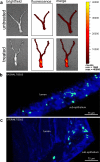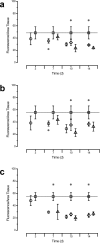Intravaginal gene silencing using biodegradable polymer nanoparticles densely loaded with small-interfering RNA
- PMID: 19404239
- PMCID: PMC2693358
- DOI: 10.1038/nmat2444
Intravaginal gene silencing using biodegradable polymer nanoparticles densely loaded with small-interfering RNA
Abstract
Vaginal instillation of small-interfering RNA (siRNA) using liposomes has led to silencing of endogenous genes in the genital tract and protection against challenge from infectious disease. Although siRNA lipoplexes are easily formulated, several of the most effective transfection agents available commercially may be toxic to the mucosal epithelia and none are able to provide controlled or sustained release. Here, we demonstrate an alternative approach using nanoparticles composed entirely of FDA-approved materials. To render these materials effective for gene silencing, we developed novel approaches to load them with high amounts of siRNA. A single dose of siRNA-loaded nanoparticles to the mouse female reproductive tract caused efficient and sustained gene silencing. Knockdown of gene expression was observed proximal (in the vaginal lumen) and distal (in the uterine horns) to the site of topical delivery. In addition, nanoparticles penetrated deep into the epithelial tissue. This is the first report demonstrating that biodegradable polymer nanoparticles are effective delivery vehicles for siRNA to the vaginal mucosa.
Figures







Comment in
-
Drug delivery: Old polymer learns new tracts.Nat Mater. 2009 Jun;8(6):447-8. doi: 10.1038/nmat2456. Nat Mater. 2009. PMID: 19458640 No abstract available.
Similar articles
-
Polymeric nanoparticles for siRNA delivery and gene silencing.Int J Pharm. 2009 Feb 9;367(1-2):195-203. doi: 10.1016/j.ijpharm.2008.09.039. Epub 2008 Oct 1. Int J Pharm. 2009. PMID: 18940242 Free PMC article.
-
Prolonged gene silencing by siRNA/chitosan-g-deoxycholic acid polyplexes loaded within biodegradable polymer nanoparticles.J Control Release. 2012 Sep 10;162(2):407-13. doi: 10.1016/j.jconrel.2012.07.006. Epub 2012 Jul 16. J Control Release. 2012. PMID: 22800573
-
The development and mechanism studies of cationic chitosan-modified biodegradable PLGA nanoparticles for efficient siRNA drug delivery.Pharm Res. 2010 Jul;27(7):1285-95. doi: 10.1007/s11095-010-0103-0. Epub 2010 Mar 23. Pharm Res. 2010. PMID: 20309616
-
Vaginal siRNA delivery: overview on novel delivery approaches.Drug Deliv Transl Res. 2020 Aug;10(4):962-974. doi: 10.1007/s13346-020-00741-4. Drug Deliv Transl Res. 2020. PMID: 32170657 Review.
-
Polymers in small-interfering RNA delivery.Nucleic Acid Ther. 2011 Jun;21(3):133-47. doi: 10.1089/nat.2011.0293. Nucleic Acid Ther. 2011. PMID: 21749290 Free PMC article. Review.
Cited by
-
Polymeric Vehicles for Nucleic Acid Delivery: Enhancing the Therapeutic Efficacy and Cellular Uptake.Recent Adv Drug Deliv Formul. 2024;18(4):276-293. doi: 10.2174/0126673878324536240805060143. Recent Adv Drug Deliv Formul. 2024. PMID: 39356099 Review.
-
siRNA applications in nanomedicine.Wiley Interdiscip Rev Nanomed Nanobiotechnol. 2010 May-Jun;2(3):305-15. doi: 10.1002/wnan.81. Wiley Interdiscip Rev Nanomed Nanobiotechnol. 2010. PMID: 20135697 Free PMC article. Review.
-
Improved Nucleic Acid Therapy with Advanced Nanoscale Biotechnology.Mol Ther Nucleic Acids. 2020 Mar 6;19:581-601. doi: 10.1016/j.omtn.2019.12.004. Epub 2019 Dec 17. Mol Ther Nucleic Acids. 2020. PMID: 31927331 Free PMC article. Review.
-
Emergence of Small Interfering RNA-Based Gene Drugs for Various Diseases.ACS Omega. 2023 Jun 1;8(23):20234-20250. doi: 10.1021/acsomega.3c01703. eCollection 2023 Jun 13. ACS Omega. 2023. PMID: 37323391 Free PMC article. Review.
-
In utero delivery of miRNA induces epigenetic alterations and corrects pulmonary pathology in congenital diaphragmatic hernia.Mol Ther Nucleic Acids. 2023 Apr 23;32:594-602. doi: 10.1016/j.omtn.2023.04.018. eCollection 2023 Jun 13. Mol Ther Nucleic Acids. 2023. PMID: 37200861 Free PMC article.
References
-
- Veazey RS, et al. Protection of macaques from vaginal SHIV challenge by vaginally delivered inhibitors of virus-cell fusion. Nature. 2005;438:99–102. - PubMed
-
- Richardson JL, Illum L. Penetration enhancement for polypeptides through epithelia. D. Routes of delivery case studies. 8. The vaginal route of peptide and protein drug delivery. Adv Drug Deliver Rev. 1992;8:341–366.
-
- Veazey RS, et al. Prevention of virus transmission to macaque monkeys by a vaginally applied monoclonal antibody to HIV-1 gp120. Nat Med. 2003;9:343–346. - PubMed
Publication types
MeSH terms
Substances
Grants and funding
LinkOut - more resources
Full Text Sources
Other Literature Sources

